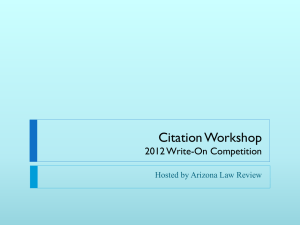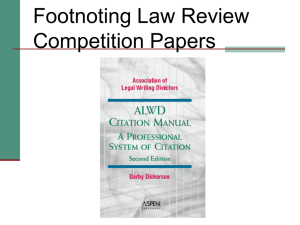TR2_LegalCitation
advertisement
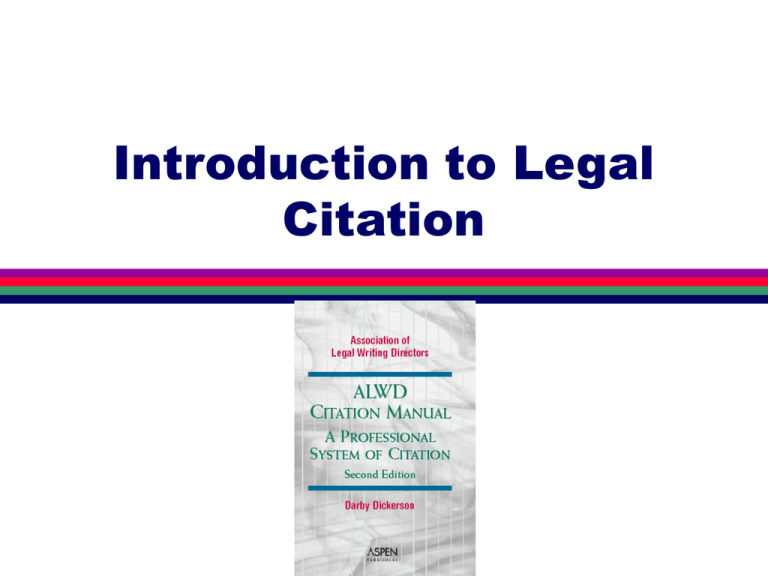
Introduction to Legal Citation What Is Citation? “Code” to help readers find the sources you refer to in your paper. • Names, abbreviations, numbers. • Author, title, volume, source abbreviation, page numbers, dates. Each source you cite will have a slightly different format. Purposes of Citations Allow reader to find and verify sources. Show weight and persuasiveness. Show type and degree of support. Show paper is well-researched. Give attribution. Background - Bluebook For 75 years, the standard has been the Bluebook. • Prepared by students at Harvard, Yale, Columbia, and Pennsylvania. • Revised every 5 years. • Much dissatisfaction with changes and format. • Practitioners’ Notes v. Law Review. ALWD Citation Manual Prepared by the Association of Legal Writing Directors. Pronounced ALL-wid. Designed as a “restatement” of citation and to replace the Bluebook. Now in its second edition (2003). ALWD Citation Manual Already been adopted by professors at about 90 law schools. If you can use the ALWD Manual, you can use the Bluebook. Many citation forms look the same -so most attorneys and judges will not know which you used. Also: Local court citation rules. Major Change from Bluebook Only one citation system for all types of documents (no more Practitioners’ Notes). Features Fast formats Sidebars Diagramed examples More examples Detailed index Local court rules Two-color design Web site for updates Organization Part One: Introductory Material Part Two: Citation Basics Part Three: Specific Print Sources • Primary, then secondary Part Four: Electronic Sources Part Five: Incorporating Citations Part Six: Quotations Part Seven: Appendices 1: 2: 3: 4: 5: 6: 7: 8: Primary sources, by jxn Local citation rules General abbreviations Court abbreviations Periodical abbreviations Sample memorandum Tax materials Fed. admin. sources (Web only) Appendices on Web Many have expanded coverage. www.alwd.org Web also has updates, clarifications, and errata. How to Find Information Start with the index. • Look up the most specific term possible. • If not there, think of a broader term or synonym. Detailed table of contents. Example of Citation To establish that a contract exists, the plaintiff must establish three elements: offer, acceptance, and consideration. Jones v. Smith, 538 S.2d 64, 67 (Fla. 1987). If these essential elements are not proven, then the plaintiff’s case will fail. Id. at 69. In some cases, the parties’ intent can be used to establish each element. Gardner v. Cooper, 876 S.2d 999, 1002-1004 (Fla. 2d Dist. App. 1994). Rule 1: Typeface Ordinary or italics (underlining). • If you underline, underline spaces. • Appendix 6 uses underlining. Each rule will tell you which parts of a citation should be in ordinary type and which should be in italics. Italicize punctuation within italicized material, but not following it (look at examples). Rule 2: Abbreviations Use the Appendices (have flexibility about whether to abbreviate). Spacing rules (let’s look at some). Rule 3: Capitalization Conform titles to this rule. Use spelling in original. Capitalize first letter of: • • • • First word in title First word in subtitle First word after colon or dash All other words except articles, prepositions, “to” as an infinitive, and coordinating conjunctions Rule 4: Numbers Generally spell out zero through ninetynine. Ordinals: 1st, 2d, 3d, 4th, 5th, etc. Rule 5: Page Numbers Use a pinpoint whenever possible. Page spans. Either: • Retain all digits: 100-111 • Drop repetitive digits, but retain two on right-hand side: 100-11 Rule 8: Supplements Material only in main volume. • (2002) Material only in supplement. • (Supp. 2002) Material in both. • (2002 & Supp. 2003) Rule 11: Intro to Full and Short Citations Use a full citation the first time you cite a source. May use a short citation thereafter. Id. Primary Sources Rule Rule Rule Rule Rule 16: 12: 13: 14: 15: Rule 17: Rule 18: Cases Constitutions Statutes Other federal legislative materials Other state legislative materials Rules (e.g., civ. pro.) Local ordinances Other Primary Sources Rule 19: Rule 20: Rule 21: Federal administrative and executive material State administrative and executive material Treaties and conventions Rule 22: Treatises Author, Title subdivisions (edition, publisher date). R. Joseph Smith & Patrice J. Goodwin, Foreign Relations in the Post-Modern World vol. 2, § 42, 310 (3d ed., West 1999). Editor instead of author? Rule 23: Periodicals Author, Title volume, periodical abbreviation initial page, pinpoint page (Date). • Consecutive v. Nonconsecutive. • Student pieces = Student Author (not Note, Comment, etc.). Appendices 3 and 5 have abbreviations. Periodical Examples Cass R. Sunstein, Affirmative Action, Caste, and Cultural Comparisons, 97 Mich. L. Rev. 1311, 1315 (1999). Gita F. Rothschild, Forum Shopping, 24 Litig. 40 (Spring 1998). Tara Burns Koch, Student Author, Betting on Brownfields--Does Florida's Brownfields Redevelopment Act Transform Liability into Opportunity?, 28 Stetson L. Rev. 171, 175 (1998). Frequency of Citation Support each thought that is not your own. “Within a single paragraph . . . if you refer to material from the same part of the same source, you may place one citation at the end of the material. Do not use this convention if the page, section, or other subdivision of the cited material changes.” Quotations (Rules 48) Block quote: 50 or more words OR four or more lines of typed text. Punctuation: • Periods and commas inside quotation marks. • Everything else outside, unless they are part of the quoted material. The End.



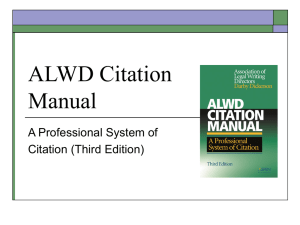
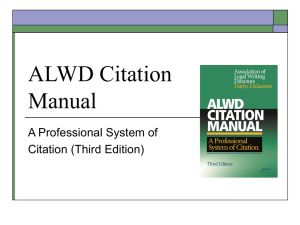
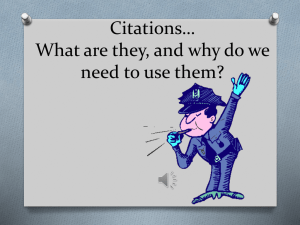

![DBQ Citations [Direct and Indirect]](http://s2.studylib.net/store/data/005429647_1-368ff05a656398a459c47105833e4c53-300x300.png)
